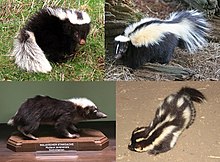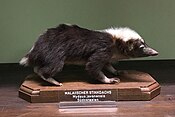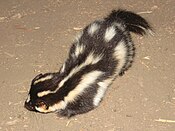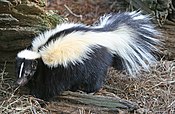J u m p t o c o n t e n t
M a i n m e n u
M a i n m e n u
N a v i g a t i o n
● M a i n p a g e ● C o n t e n t s ● C u r r e n t e v e n t s ● R a n d o m a r t i c l e ● A b o u t W i k i p e d i a ● C o n t a c t u s ● D o n a t e
C o n t r i b u t e
● H e l p ● L e a r n t o e d i t ● C o m m u n i t y p o r t a l ● R e c e n t c h a n g e s ● U p l o a d f i l e
S e a r c h
Search
A p p e a r a n c e
● C r e a t e a c c o u n t ● L o g i n
P e r s o n a l t o o l s
● C r e a t e a c c o u n t ● L o g i n
P a g e s f o r l o g g e d o u t e d i t o r s l e a r n m o r e ● C o n t r i b u t i o n s ● T a l k
( T o p )
1 G e n e r a
2 R e f e r e n c e s
T o g g l e t h e t a b l e o f c o n t e n t s
M e p h i t i d a e
8 3 l a n g u a g e s
● ا ل ع ر ب ي ة ● A s t u r i a n u ● A v a ñ e ' ẽ ● A y m a r a r u ● ت ۆ ر ک ج ه ● B a n j a r ● 閩 南 語 / B â n - l â m - g ú ● Б е л а р у с к а я ● Б е л а р у с к а я ( т а р а ш к е в і ц а ) ● Б ъ л г а р с к и ● བ ོ ད ་ ཡ ི ག ● B r e z h o n e g ● C a t a l à ● C e b u a n o ● Č e š t i n a ● C h i S h o n a ● C y m r a e g ● D a n s k ● D e u t s c h ● D i n é b i z a a d ● E e s t i ● E s p a ñ o l ● E s p e r a n t o ● E u s k a r a ● ف ا ر س ی ● F ø r o y s k t ● F r a n ç a i s ● G a e i l g e ● G a l e g o ● 한 국 어 ● Հ ա յ ե ր ե ն ● H r v a t s k i ● I d o ● B a h a s a I n d o n e s i a ● I n t e r l i n g u a ● I t a l i a n o ● ע ב ר י ת ● K i s w a h i l i ● K o t a v a ● ລ າ ວ ● L a t i n a ● L a t v i e š u ● L i e t u v i ų ● M a g y a r ● മ ല യ ാ ള ം ● م ص ر ى ● م ا ز ِ ر و ن ی ● М о н г о л ● N e d e r l a n d s ● 日 本 語 ● N a p u l i t a n o ● N o r d f r i i s k ● N o r s k b o k m å l ● O c c i t a n ● پ ن ج ا ب ی ● P o l s k i ● P o r t u g u ê s ● R o m â n ă ● R u n a S i m i ● Р у с с к и й ● S h q i p ● S i m p l e E n g l i s h ● S l o v e n č i n a ● S l o v e n š č i n a ● S o o m a a l i g a ● С р п с к и / s r p s k i ● S r p s k o h r v a t s k i / с р п с к о х р в а т с к и ● S u o m i ● S v e n s k a ● T a g a l o g ● த ம ி ழ ் ● T a q b a y l i t ● ไ ท ย ● Ꮳ Ꮃ Ꭹ ● T s e t s ê h e s t â h e s e ● T ü r k ç e ● У к р а ї н с ь к а ● T i ế n g V i ệ t ● W i n a r a y ● 吴 语 ● י י ִ ד י ש ● 粵 語 ● 中 文
E d i t l i n k s
● A r t i c l e ● T a l k
E n g l i s h
● R e a d ● E d i t ● V i e w h i s t o r y
T o o l s
T o o l s
A c t i o n s
● R e a d ● E d i t ● V i e w h i s t o r y
G e n e r a l
● W h a t l i n k s h e r e ● R e l a t e d c h a n g e s ● U p l o a d f i l e ● S p e c i a l p a g e s ● P e r m a n e n t l i n k ● P a g e i n f o r m a t i o n ● C i t e t h i s p a g e ● G e t s h o r t e n e d U R L ● D o w n l o a d Q R c o d e ● W i k i d a t a i t e m
P r i n t / e x p o r t
● D o w n l o a d a s P D F ● P r i n t a b l e v e r s i o n
I n o t h e r p r o j e c t s
● W i k i m e d i a C o m m o n s ● W i k i s p e c i e s
A p p e a r a n c e
F r o m W i k i p e d i a , t h e f r e e e n c y c l o p e d i a
Mephitidae is a family of mammals comprising the skunks and stink badgers . They are noted for the great development of their anal scent glands , which they use to deter predators. Skunks were formerly classified as a subfamily of the Mustelidae (the weasel family); however, in the 1990s, genetic evidence caused skunks to be treated as a separate family.[1] retroposon markers indicated that they are most closely related to the Ailuridae (red pandas and allies) and Procyonidae (raccoons and allies)[citation needed .
There are twelve extant species of mephitids in four genera : Conepatus hog-nosed skunks , four species); Mephitis hooded and striped skunks , two species); Mydaus Spilogale spotted skunks , four species). The two stink badgers in the genus Mydaus inhabit Indonesia , Brunei , Malaysia and the Philippines ; the other members of the family inhabit the Americas, ranging from Canada to central South America. All other mephitids are extinct, known through fossils, including those from Eurasia .[2] [3] [4]
In taxonomic order, the living species of Mephitidae are:[5]
References [ edit ]
^ Koepfli KP, Deere KA, Slater GJ, et al. (2008). "Multigene phylogeny of the Mustelidae: Resolving relationships, tempo and biogeographic history of a mammalian adaptive radiation" . BMC Biol . 6 doi :10.1186/1741-7007-6-10 PMC 2276185 PMID 18275614 .
^ Mammal Species of the World – Browse: Mephitidae . Bucknell.edu. Retrieved on April 5, 2012.
^ Wilson, D. E. ; Reeder, D. M., eds. (2005). Mammal Species of the World: A Taxonomic and Geographic Reference ISBN 978-0-8018-8221-0 OCLC 62265494 .
R e t r i e v e d f r o m " https://en.wikipedia.org/w/index.php?title=Mephitidae&oldid=1233193433 " C a t e g o r i e s : ● M e p h i t i d a e ● M a m m a l f a m i l i e s ● T a x a n a m e d b y C h a r l e s L u c i e n B o n a p a r t e H i d d e n c a t e g o r i e s : ● A r t i c l e s w i t h s h o r t d e s c r i p t i o n ● S h o r t d e s c r i p t i o n m a t c h e s W i k i d a t a ● E n g v a r B f r o m J u n e 2 0 2 2 ● U s e d m y d a t e s f r o m J u n e 2 0 2 2 ● A r t i c l e s w i t h ' s p e c i e s ' m i c r o f o r m a t s ● A l l a r t i c l e s w i t h u n s o u r c e d s t a t e m e n t s ● A r t i c l e s w i t h u n s o u r c e d s t a t e m e n t s f r o m A u g u s t 2 0 2 1 ● A r t i c l e s w i t h G N D i d e n t i f i e r s ● A r t i c l e s w i t h L C C N i d e n t i f i e r s ● A r t i c l e s w i t h N K C i d e n t i f i e r s
● T h i s p a g e w a s l a s t e d i t e d o n 7 J u l y 2 0 2 4 , a t 1 9 : 4 9 ( U T C ) . ● T e x t i s a v a i l a b l e u n d e r t h e C r e a t i v e C o m m o n s A t t r i b u t i o n - S h a r e A l i k e L i c e n s e 4 . 0 ;
a d d i t i o n a l t e r m s m a y a p p l y . B y u s i n g t h i s s i t e , y o u a g r e e t o t h e T e r m s o f U s e a n d P r i v a c y P o l i c y . W i k i p e d i a ® i s a r e g i s t e r e d t r a d e m a r k o f t h e W i k i m e d i a F o u n d a t i o n , I n c . , a n o n - p r o f i t o r g a n i z a t i o n . ● P r i v a c y p o l i c y ● A b o u t W i k i p e d i a ● D i s c l a i m e r s ● C o n t a c t W i k i p e d i a ● C o d e o f C o n d u c t ● D e v e l o p e r s ● S t a t i s t i c s ● C o o k i e s t a t e m e n t ● M o b i l e v i e w







